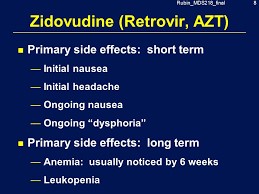A client who is receiving zidovudine reports the appearance of pinpoint, red, round spots on the skin. Which result should the nurse report to the healthcare provider?
Complete blood count.
Allergy test.
Skin biopsy.
Electromyography.
The Correct Answer is A
A) Correct- Zidovudine is an antiretroviral medication used in the treatment of HIV infection.
One of the potential side effects of zidovudine is hematological toxicity, including anemia (low red blood cell count) and neutropenia (low white blood cell count). The appearance of pinpoint, red, round spots on the skin could be indicative of petechiae, which are small hemorrhages caused by the leakage of blood into the skin. Petechiae can occur due to low platelet counts, a
component of the complete blood count (CBC). Monitoring the complete blood count is important for clients receiving zidovudine to identify any potential adverse effects on blood cell counts. Anemia and neutropenia can increase the risk of infection, bleeding, and other complications. Therefore, any changes in blood cell counts, including the presence of petechiae, should be reported to the healthcare provider for further evaluation and management.
B) Incorrect- This is used to assess allergic reactions and is not specifically related to the appearance of petechiae.
C) Incorrect- A skin biopsy is typically performed to diagnose skin conditions or diseases and is not the primary assessment to evaluate the cause of petechiae.
D) Incorrect- Electromyography is a diagnostic test used to assess muscle and nerve function and is not relevant to the appearance of petechiae associated with zidovudine use.

Nursing Test Bank
Naxlex Comprehensive Predictor Exams
Related Questions
Correct Answer is D
Explanation
A) Incorrect- Dizziness is a common side effect of ramelteon and may occur initially as the body adjusts to the medication. While it's important to monitor and address dizziness, it may not require immediate reporting unless it's severe or persistent.
B) Incorrect- A change in the sleep-wake cycle is expected when using medications to treat sleep disorders. Ramelteon is designed to help regulate sleep patterns, so a change in the sleep-wake cycle is an anticipated effect.
C) Incorrect- Mild sedation is a common side effect of ramelteon and is usually well-tolerated.
It's important to educate the client about potential sedation effects and advise them not to engage in activities that require full alertness until they know how the medication affects them.
D) Correct- Somnambulism, also known as sleepwalking, is a potentially dangerous side effect that needs immediate attention from the healthcare provider. The client's safety is at risk due to the potential for injury during sleepwalking episodes.
Correct Answer is D
Explanation
The correct answer is choiced. Children usually resume their toileting behaviors when they leave the hospital.
Choice A rationale:
While it is true that hospitalization can be stressful for preschoolers, providing diapers may not be necessary. Regression in toileting is often temporary and related to the stress of the hospital environment.
Choice B rationale:
Initiating a retraining program immediately after returning home may not be necessary. Most children will naturally resume their previous toileting behaviors once they are back in a familiar and less stressful environment.
Choice C rationale:
Bringing a potty chair from home can be helpful in some cases, but it is not always practical or necessary. The child is likely to resume normal toileting behaviors once they are back in their usual environment.
Choice D rationale:
This is the correct answer because children often regress in their toileting behaviors due to the stress and unfamiliarity of the hospital environment.Once they return home, they typically resume their previous toileting habits.
Whether you are a student looking to ace your exams or a practicing nurse seeking to enhance your expertise , our nursing education contents will empower you with the confidence and competence to make a difference in the lives of patients and become a respected leader in the healthcare field.
Visit Naxlex, invest in your future and unlock endless possibilities with our unparalleled nursing education contents today
Report Wrong Answer on the Current Question
Do you disagree with the answer? If yes, what is your expected answer? Explain.
Kindly be descriptive with the issue you are facing.
